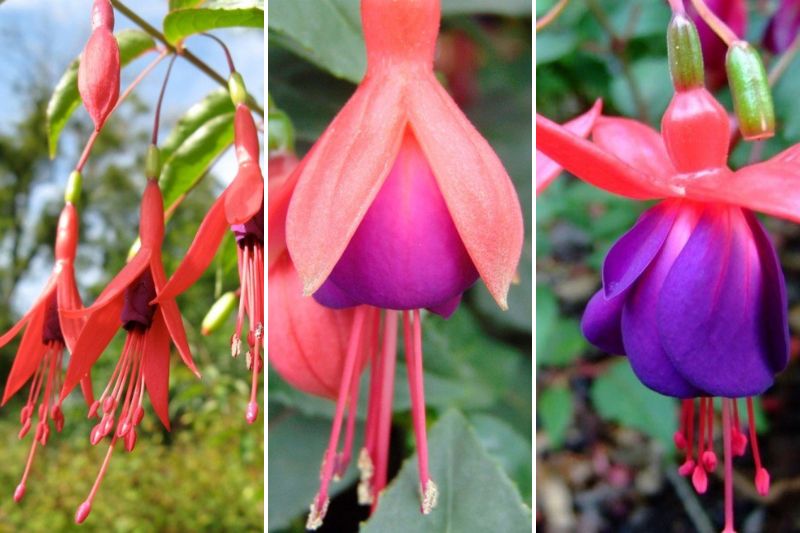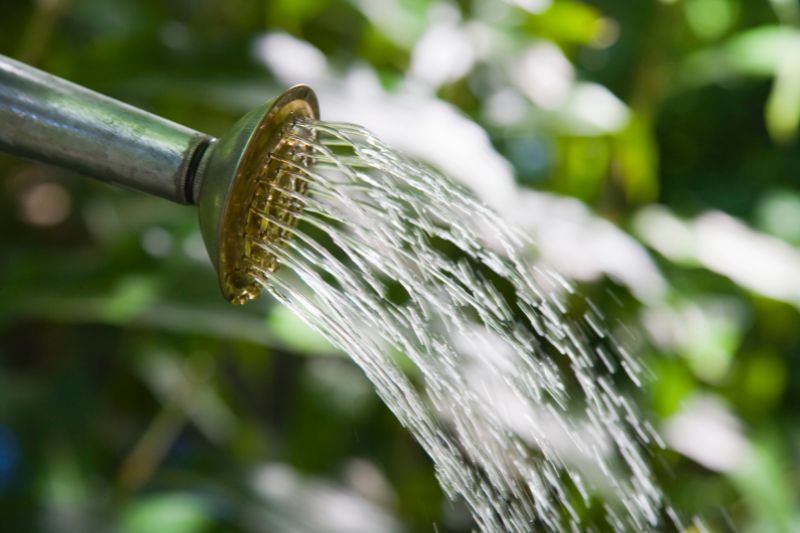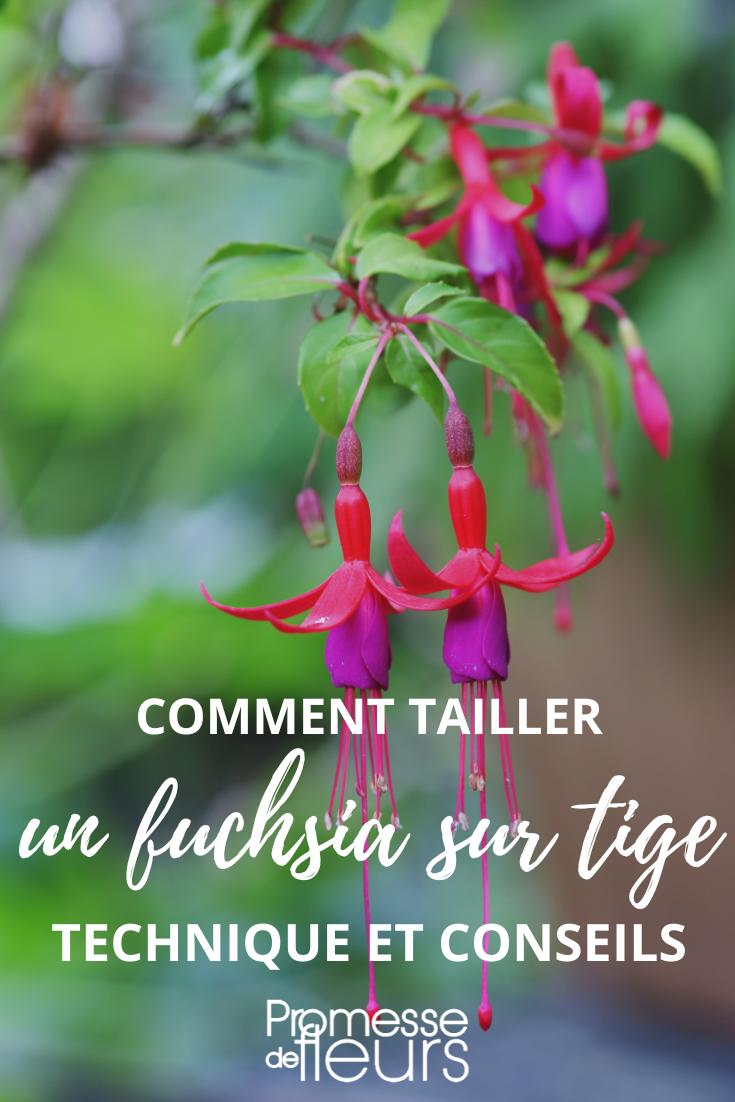Fuchsias brighten shady areas of garden with their small, colourful, pendulous bell-shaped flowers throughout summer. These perennials can take several forms: bushy, trailing, spreading or on a stem. In the latter case, the fuchsia bears an upright, straight trunk ending in a rounded tuft of leaves. It then becomes a true little bush on a stem, which will bring good volume and a graphic touch to garden or container.
This fairly simple technique to carry out at home will mainly require patience to obtain a good specimen. So follow our tutorial to learn how to train your fuchsia on a stem as well as our care tips.
Which varieties to choose for creating a fuchsia on a stem?
To obtain a fuchsia on a stem, favour erect varieties with an upright habit that are sufficiently vigorous. Ideally, they should reach at least 50 to 75 cm in height. Choose them mainly according to the final height you want for your stem-bush. Conversely, avoid spreading varieties, wider than tall, or climbing varieties whose branches must be supported.
Opt for example for:
- Fuchsia magellanica ‘Riccartonii’ (Fuchsia magellanica) (‘Riccartonii’) — 1.20 metres high with 60 cm spread, or ‘Gracilis’ — 1.50 metres high with 60 cm spread;
- the hybrid Fuchsia ‘Mrs Popple’, with an upright habit reaching 1 metre in height for 70 cm spread;
- the hybrid Fuchsia 'Marjory Black', with an erect silhouette about 90 cm high for 50 cm spread.
Choose a healthy young plant with a well-vertical central stem. It can come from a potted plant or be produced by cutting.

When to train a fuchsia on a stem?
The ideal period to train a fuchsia on a stem is during the growing season, from late spring to late summer (from late May to early September).
Steps to prune and form a fuchsia on a stem
Staking
To obtain a nice fuchsia on a trunk, the first step is to stake the central stem, so it develops straight and vertical.
- Choose a stake taller than the final height of your stem.
- Insert it gently into the potting mix, about 5 to 10 cm from the plant.
- Tie the main stem at several heights using ties (about every 5 cm), so it is stable but not too tight to allow the sap to continue to circulate.
- As it grows, add additional ties to allow the stem to develop in height.
- Also adjust older ties so the stem can thicken without being strangled.
Pruning
To train a bush on a stem, the 2nd step is to remove new shoots regularly, to allow sap to rise.
- Using a pruning shear (or by hand), cut all new lateral shoots as soon as they reach about 10 cm in length. You can use them to take cuttings. For how to proceed, follow our tutorial "Propagate fuchsia".
- Also remove any suckers arising from the stump.
- Allow leaves on the central stem to develop, to enable photosynthesis.
- Keep 4 to 6 branches at the top of the stem, which will form the crown.
- Once the desired height is reached, pinch out the top of the main stem between your nails to stop its growth.
- Prune the crown branches so they are the same length, to form a neat, balanced and compact head. To obtain an even display, you can turn the pot of your fuchsia by about ¼ turn once a week.
Depending on your fuchsia's growth and growing conditions, you will obtain your stem-bush after about 1 to 2 years. When the plant is well formed and stable enough, you can remove the stake and the ties.

Exposure
Place the pot of your fuchsia on a stem outdoors from spring to autumn, away from risk of frost. Choose a spot that is fairly bright, preferably semi-shaded, and sheltered from direct sunlight and prevailing winds.
Materials needed
Training a fuchsia on a stem requires little equipment:
- a pruning shear that is clean and sharp;
- a vertical stake in bamboo, PVC or plastic-coated steel;
- ties or stake collars.
Care of fuchsia on a stem
Repotting or transplanting
After 2 to 3 years, your fuchsia on a stem will normally be large and sturdy enough to be repotted into a larger container. Choose a container that is heavy and stable so it will not be tipped by your fuchsia's silhouette.
You can also choose to transplant it into the ground.
Pruning
In late winter, before growth resumes, remove new lateral shoots, dried or damaged stems, and any suckers.
During flowering, remove faded flowers as they appear.
Watering
Fuchsia needs soil that is kept fresh (moist but not waterlogged). Water regularly, as soon as the top 2 centimetres of the potting mix are dry. Frequency will be from once to several times a week during the growing season, depending on weather conditions.
Prefer rainwater, which is less hard and chlorinated than tap water.
If you have a saucer under the container, empty it about twenty minutes after watering.

Feeding
Fuchsias are quite hungry plants that appreciate soils rich in organic matter.
Throughout the growing season, from late spring to late summer, apply regular fertiliser. In the first year, favour a fertiliser fairly rich in nitrogen to support leafy growth. In subsequent years, choose a more balanced fertiliser to also encourage flowering: turn to a fertiliser for containers and pots or a specific fertiliser for geraniums and flowering plants.
Follow dosage instructions indicated on the products.
You can also opt for organic feeds, such as well-rotted household compost or manure, worked in lightly by fork in spring.
Overwintering
Fuchsias are not very hardy. In particular, potted varieties and fuchsias on a stem are even more sensitive to frost. Before the end of autumn, bring your fuchsia into an unheated, frost-free room (greenhouse, conservatory…), where temperature will be about 5 to 10°C.
If your fuchsia on a stem is planted in the ground, it is advisable to lift it (except in regions with mild winters little prone to frost). Remove the plant’s root system with its soil ball and transfer it to a container to shelter.
Reduce watering to about once every 15 days and stop feeding.
Find more advice in the article « Fuchsia: how to overwinter? ».
































Comments